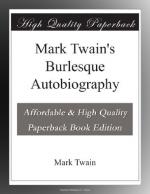At his right hand, and convenient to the warrior’s grasp, hung his mangonel or mace—a terrific weapon which had shattered the brains of many a turbaned soldan; while over his broad and ample chest there fell the triangular shield of the period, whereon were emblazoned his arms—argent, a gules wavy, on a saltire reversed of the second: the latter device was awarded for a daring exploit before Ascalon, by the Emperor Maximilian, and a reference to the German Peerage of that day, or a knowledge of high families which every gentleman then possessed, would have sufficed to show at once that the rider we have described was of the noble house of Hombourg. It was, in fact, the gallant knight Sir Ludwig of Hombourg: his rank as a count, and chamberlain of the Emperor of Austria, was marked by the cap of maintenance with the peacock’s feather which he wore (when not armed for battle), and his princely blood was denoted by the oiled silk umbrella which he carried (a very meet protection against the pitiless storm), and which, as it is known, in the middle ages, none but princes were justified in using. A bag, fastened with a brazen padlock, and made of the costly produce of the Persian looms (then extremely rare in Europe), told that he had travelled in Eastern climes. This, too, was evident from the inscription writ on card or parchment, and sewed on the bag. It first ran “Count Ludwig de Hombourg, Jerusalem;” but the name of the Holy City had been dashed out with the pen, and that of “Godesberg” substituted. So far indeed had the cavalier travelled!—and it is needless to state that the bag in question contained such remaining articles of the toilet as the high-born noble deemed unnecessary to place in his valise.
“By Saint Bugo of Katzenellenbogen!” said the good knight, shivering, “’tis colder here than at Damascus! Marry, I am so hungry I could eat one of Saladin’s camels. Shall I be at Godesberg in time for dinner?” And taking out his horologe (which hung in a small side-pocket of his embroidered surcoat), the crusader consoled himself by finding that it was but seven of the night, and that he would reach Godesberg ere the warder had sounded the second gong.
His opinion was borne out by the result. His good steed, which could trot at a pinch fourteen leagues in the hour, brought him to this famous castle, just as the warder was giving the first welcome signal which told that the princely family of Count Karl, Margrave of Godesberg, were about to prepare for their usual repast at eight o’clock. Crowds of pages and horse-keepers were in the court, when, the portcullis being raised, and amidst the respectful salutes of the sentinels, the most ancient friend of the house of Godesberg entered into its castle-yard. The under-butler stepped forward to take his bridle-rein. “Welcome, Sir Count, from the Holy Land!” exclaimed the faithful old man. “Welcome, Sir Count, from the Holy Land!” cried the rest of the servants in the hall. A stable was speedily




